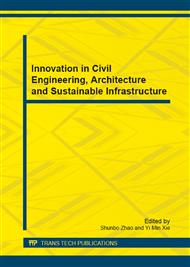p.697
p.701
p.705
p.709
p.714
p.719
p.723
p.728
p.733
Design of Mitigation Damper with Support Flexibility for Stay Cable under Bridge Deck Excitation
Abstract:
This paper studies cable-damper mitigation model due to indirect excitation caused by bridge deck excitation. In the new mitigation model, as a rule of thumb, we considered an attached spring associated in tandem with a damper to simulate the supporter flexibility. The result shows that the interaction between the flexibility of the support in the viscous damper could deeply impact the damper effectiveness, and the external damping should be increased deeply to provide the same non-dimensional modal damping when the inclined angle of cable decreases. The optimum damping coefficient of the non-idealized damper increases when the flexibility of the supporter increases.
Info:
Periodical:
Pages:
714-718
Citation:
Online since:
November 2012
Authors:
Keywords:
Price:
Сopyright:
© 2012 Trans Tech Publications Ltd. All Rights Reserved
Share:
Citation:


